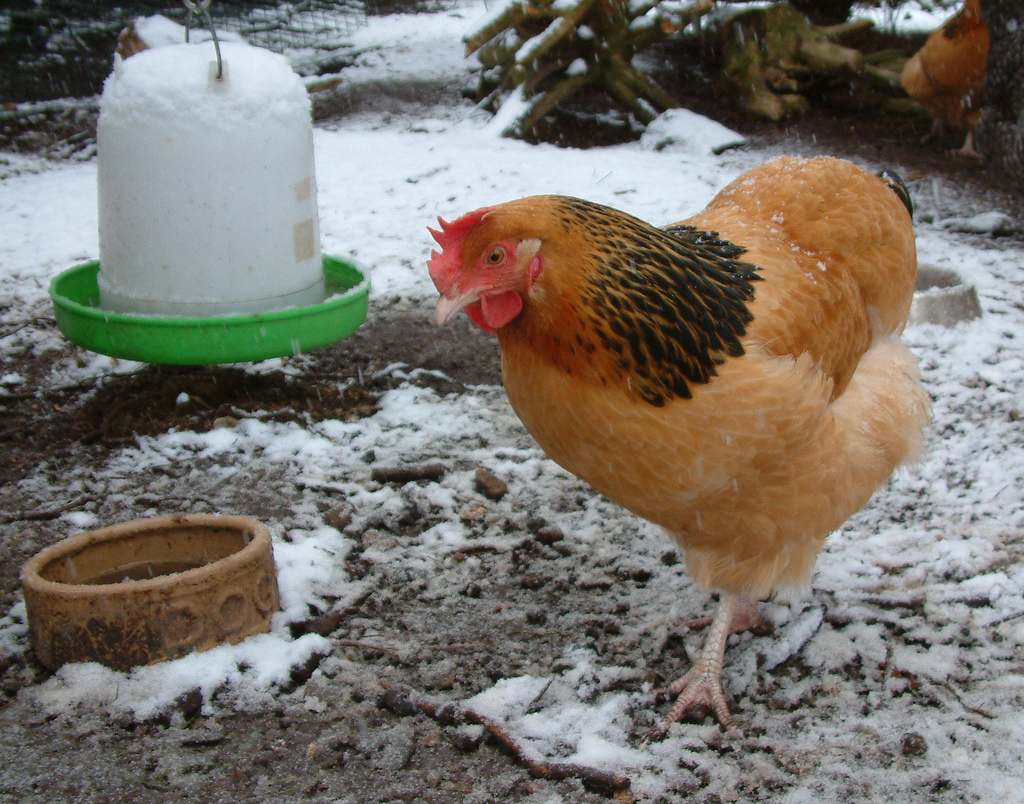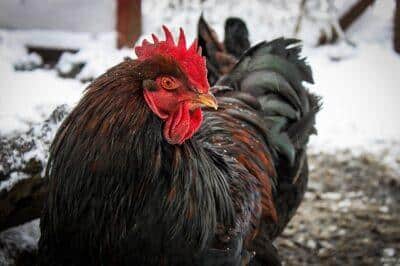|
Listen To The Article
|
Frostbite can take place within minutes of flesh being exposed to wet, cold temperatures – and it can impact your chickens, too.
Chickens do have a covering of feathers to keep them warm, but their legs, feet, comb and wattles are left completely exposed. These areas are the most common places for a chicken to have frostbite. With proper monitoring and care once a case has been developed, the chicken still can live a long and happy egg-producing life.
Causes
Freezing temperatures are not the only cause of frostbite, as moisture is a large factor, too. Areas on the bird that get wet and then exposed to freezing temperatures are greatly impacted. Wind chill is another factor. Moisture in the air, combined with high winds and freezing temperatures, can quickly lead to frostbite.
Prevention
Wattles can become wet when the chicken drinks from a traditional chicken watering container. This moisture can freeze in place, causing frostbite. Wet coop and run floors are also a leading cause of frostbite on the feet. The coop should be cleaned regularly to prevent moisture in the coop. Ventilation is also key to maintaining lower moisture levels, although wind blocks should be installed on the run to keep the wind exposure down.
Diagnosis
Determining if the chicken has frostbite is quite simple. Color change in the legs, feet, wattle or comb are good indications of frostbite. Birds who experience swelling, blisters, black tissue, loss of appetite and loss of energy should be doctored.
Care
Remove the bird immediately and relocate it to a warm environment. A location inside the home, basement, garage or barn will all work, provided they are warmer than the coop and completely free from the wind. The bird should be kept in this location until it has fully healed. Placing it back among the population could give the other birds something to peck at, making the affected area worse.
Diatomaceous Earth: The All-Natural Livestock De-Wormer! [2]
Slowly warm the affected area on the bird by soaking the feet in a lukewarm Epsom salt bath. Do not allow the water temperatures to top 100 degrees Fahrenheit. Providing water that is too warm will heat up the area too quickly and may cause further damage. It also will cause a great deal of discomfort to the bird. Never use a heating pad, hair dryer or another source of direct heat. If the comb or wattle is affected, soak a towel in the solution and gently press against the affected area. Do not rub the area; this not only will cause more discomfort to the bird but will also cause more damage. Leave any blisters or damaged tissue alone. They are there to protect the new flesh beneath it from further damage.
Treating an open wound
If an area has been opened, clean the wound with peroxide and allow to dry. The area should be kept clean and dry at all times. Apply a layer of cream to the area. This will protect the area and provide assistance with healing properly. Steer clear from water-based oils; they will only freeze and make the injury worse. Coconut oil and petroleum jelly are great choices.
If a veterinarian is an affordable and reasonable option, consider calling one. Pain medicines are available with a prescription from a veterinarian, but aspirin is another option. Regular run-of-the-mill human aspirin will suffice. Dissolve five pills in a gallon of water and give it to the bird over a period of one to three days; this will alleviate the pain and discomfort that the chicken may be experiencing.
Vitamins are important
Vitamins should be given to the chicken to assist in fighting off infection. Manufactured versions are available at most farm stores, although a more natural approach would be to provide dandelion. Fresh dandelion likely won’t be available, but adding some dried dandelion to the water will provide a great boost of vitamins. In fact, giving it to the entire flock year-round isn’t a bad idea.
The affected area should be monitored frequently for signs of infection. If the area has begun to swell, turn red, ooze, or has a bad smell, it is likely that infection has set in. Antibiotics should be given to the bird to assist in fighting off the infection. Fresh garlic is a natural antibiotic and can be provided to the bird as a natural alternative to manufactured versions.
With proper care and monitoring, the bird should be healed within a few days to a few weeks. After that, it can be returned to the rest of the bird population. Wait until temperatures have risen above freezing to avoid a second case of frostbite.
Harness The Power Of Nature’s Most Remarkable Healer: Vinegar [4]


